Unboxing, dimensions and connections
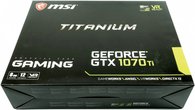 With the Titanium series, MSI visually complements the already introduced motherboards with the same name addition by letting silver metallic surfaces dominate. We can look forward to seeing if MSI can score as well with the same cooler as the GeForce GTX 1080 Ti as in our older tests of the bigger sister.
With the Titanium series, MSI visually complements the already introduced motherboards with the same name addition by letting silver metallic surfaces dominate. We can look forward to seeing if MSI can score as well with the same cooler as the GeForce GTX 1080 Ti as in our older tests of the bigger sister.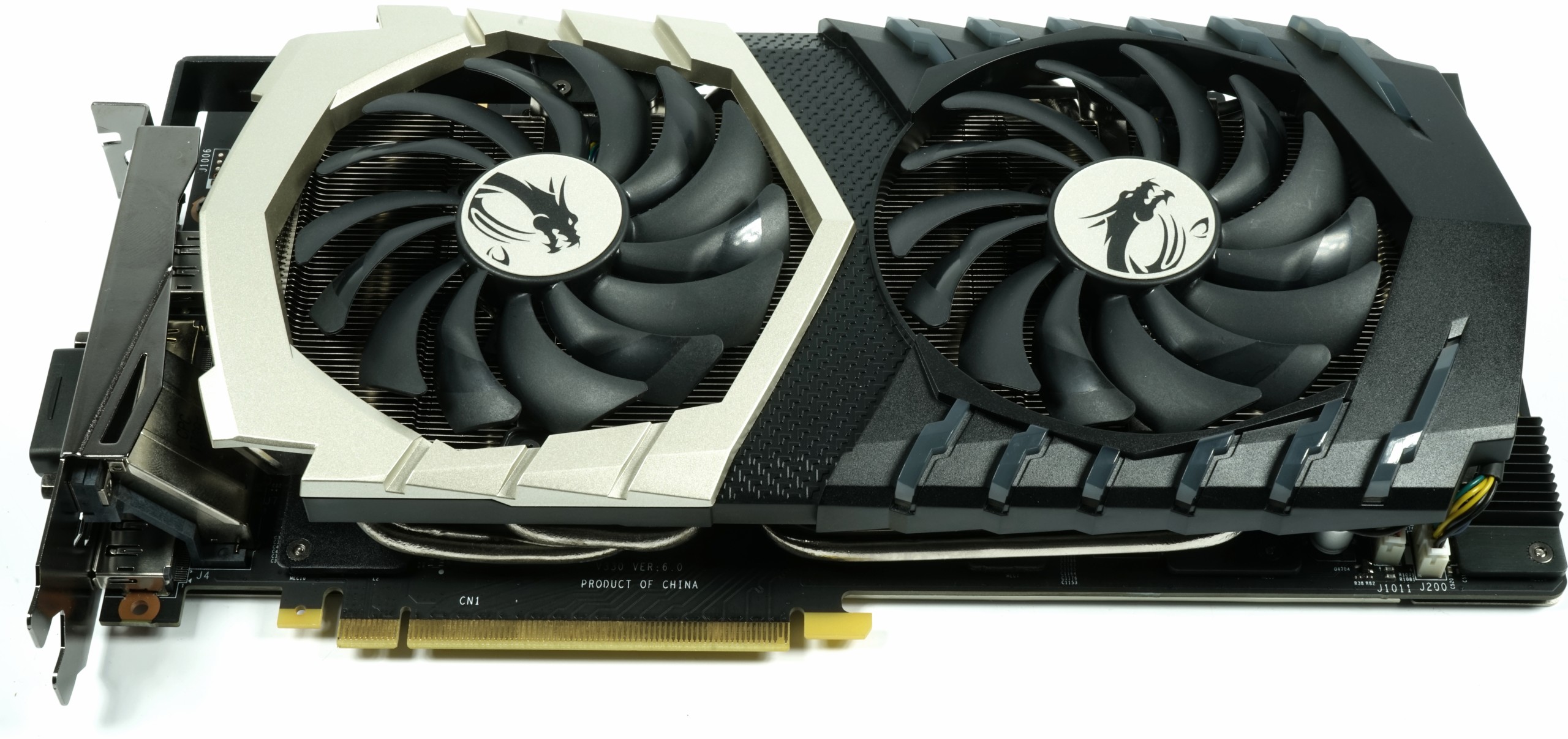
We will discuss the exact board and cooling design separately later. The most important features are first summarized in a table:
| Overview of installation dimensions, features and connections | |
|---|---|
| Installation length: |
28.3 cm (slot aperture to end cover) |
| Installation height: |
13.5 cm (upper edge slot to top card) |
| Depth: |
3.8 cm (2-slot) 0.5 cm baking plate |
| Weight: |
1080 grams |
| Backplate: | Yes, without passive cooling function |
| Cooling: | Air |
| Connections Slot blend: |
3x DisplayPort 1.4 1x HDMI 2.0 1x Dual-Link DVI-I |
| Other shots: |
2x SLI Connector |
| Power supply: |
8-Pin + 6-Pin PCI-Express |
Exterior views
Let's start by looking at the map from the outside. Instead of the red accents, MSI dyes parts of the cover in silver-metallic matte style. Otherwise, this plastic cover of the Twin-Frozr IV design could also pass as Gaming X. Once again, two large 10cm fans with a total of 14 rotor blades dominate.
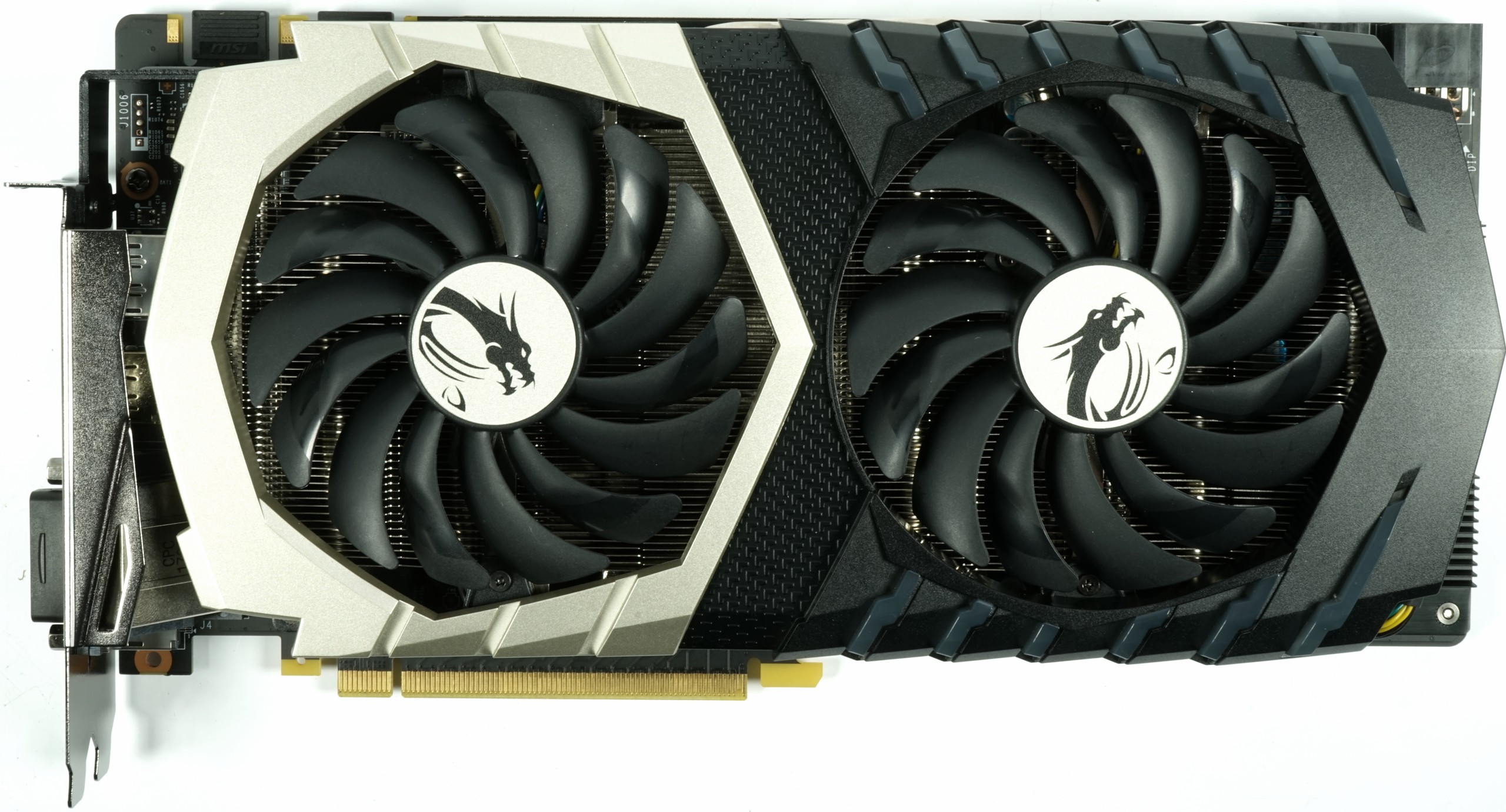 |
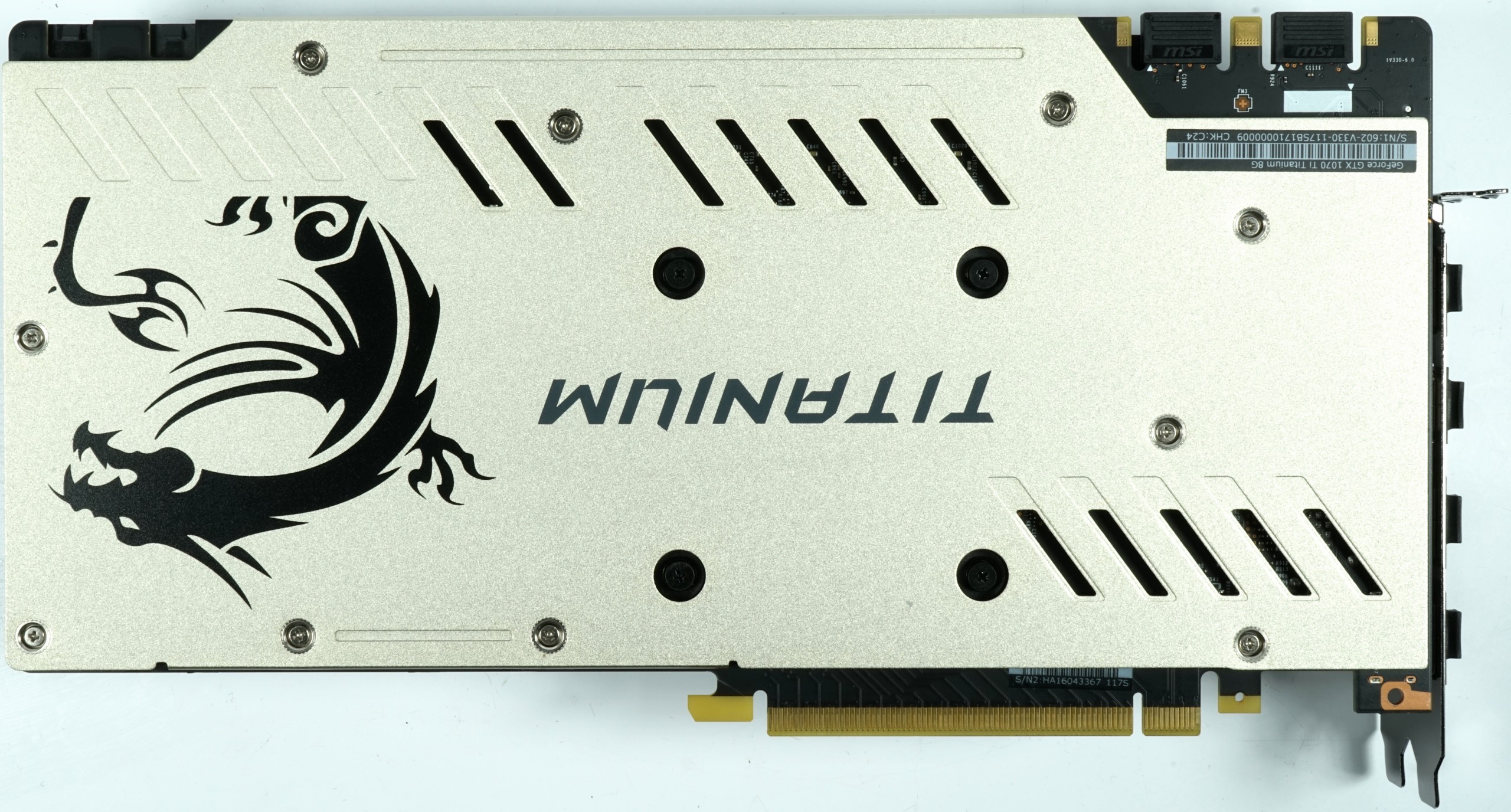 |
The backplate is purely for the look and bears a printed logo. The 8-pin and 6-pin sockets of the external power supply are installed rotated by 180°. The logo on the top is also equipped with an RGB backlight and can of course also be customized by means of its own software.

The cooling fins are thankfully horizontally aligned, which helps to transport the exhaust air at least to some extent out of the housing and does not push against the motherboard and sidewall.

In addition to the three DisplayPort jacks, the connectors are set to an HDMI output. The Dual-Link DVI connector is a nice, but now hardly necessary entry.
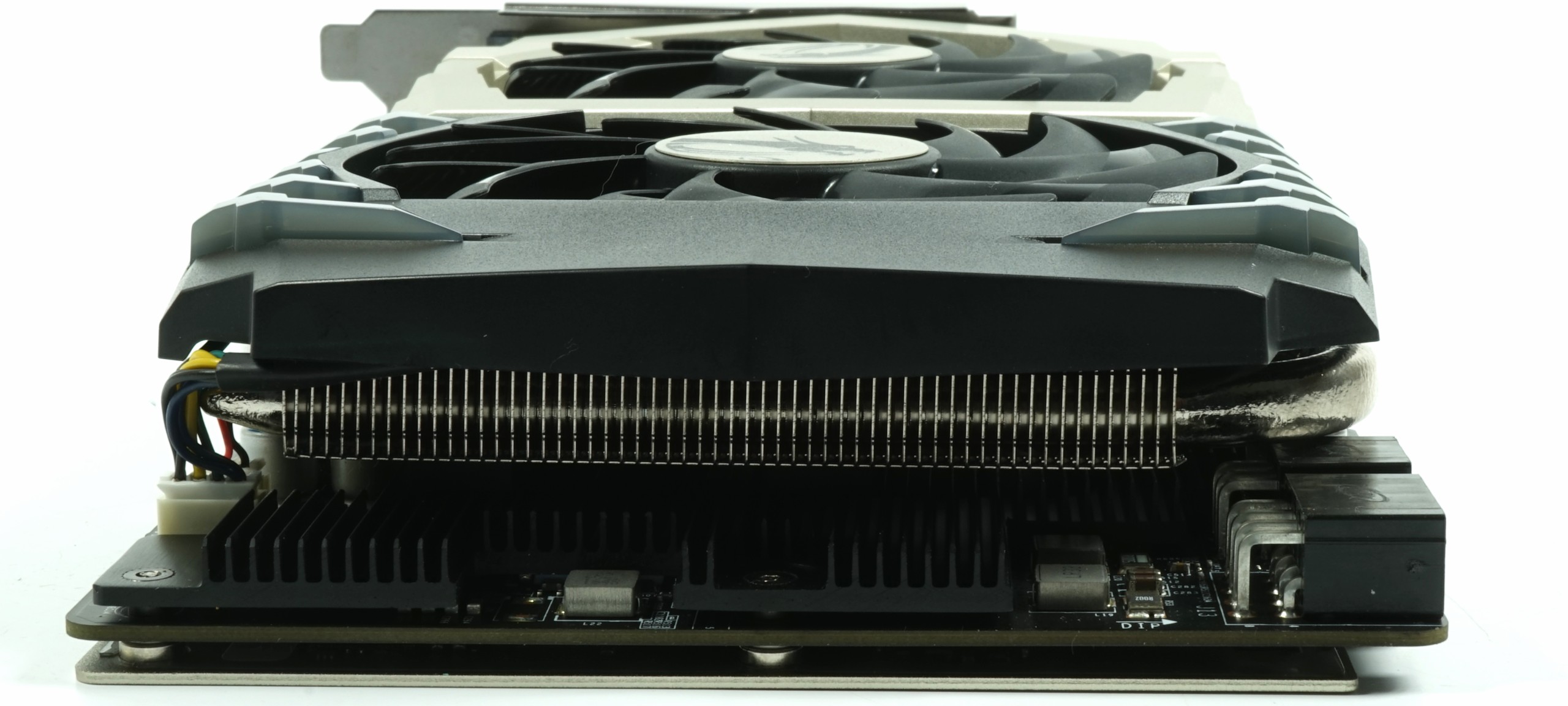 |
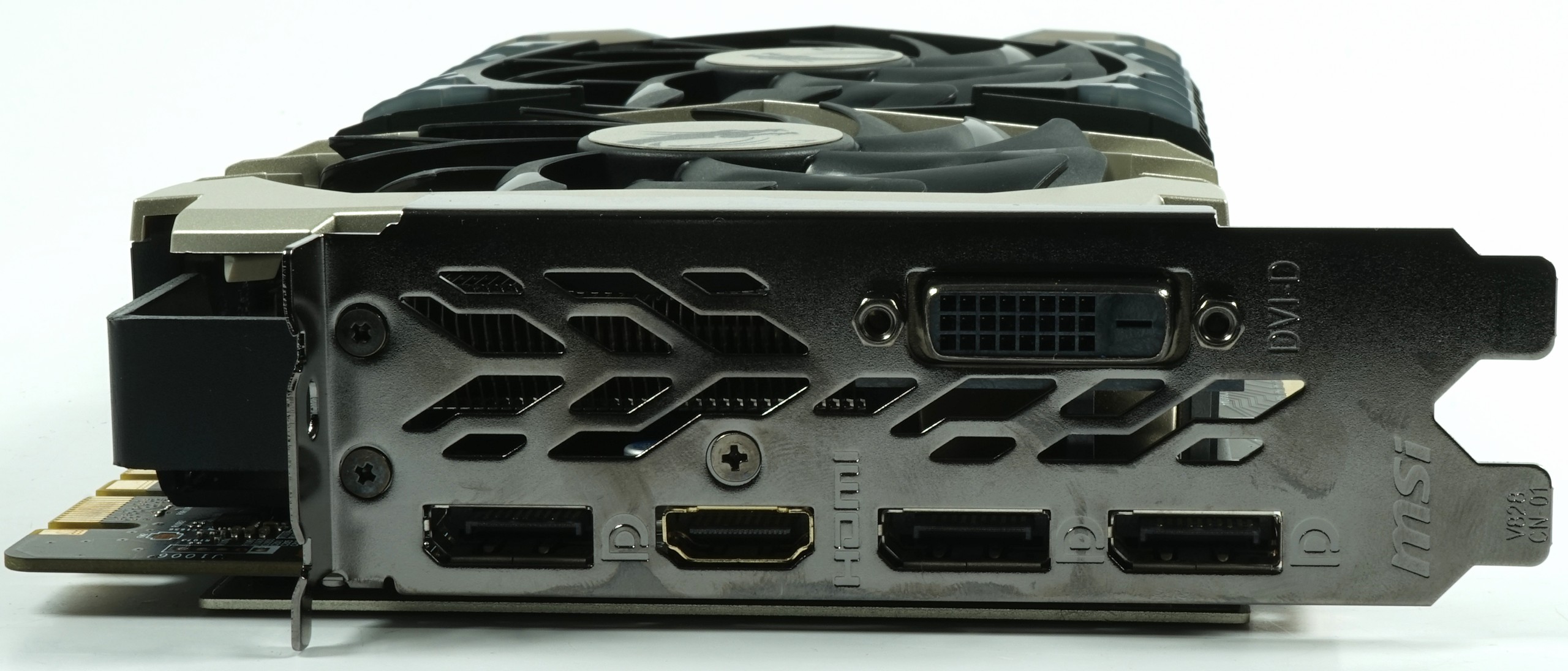 |
Cooling system and backplate
The inside-foiled backplate is visually safe to enter and also helps to attach the two front cooling elements, but unfortunately it does not offer active cooling.
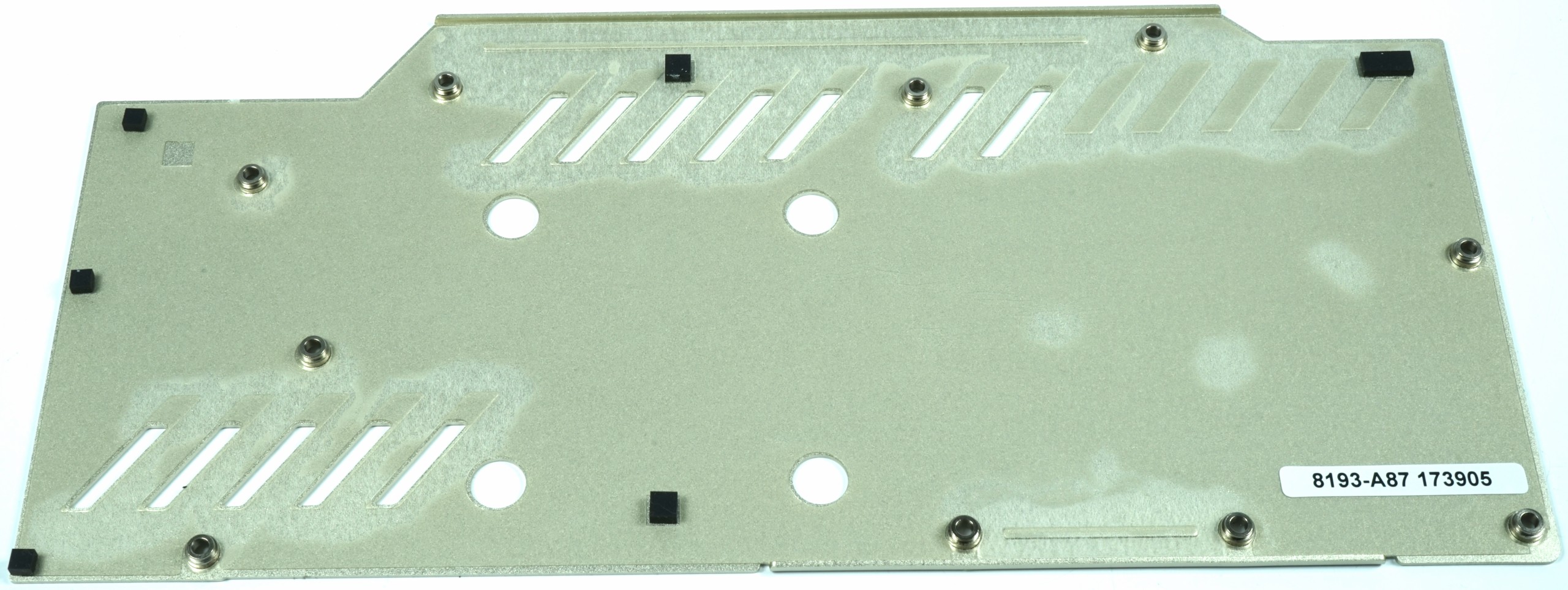
The special feature of the cooling is the use of a shortened "sandwich" system, which uses a kind of cooling and stabilization frame between the top of the board and the actual heat sink. In addition, you can rely on a separate VRM cooler for the 8 GPU voltage converters and the two of the memory.
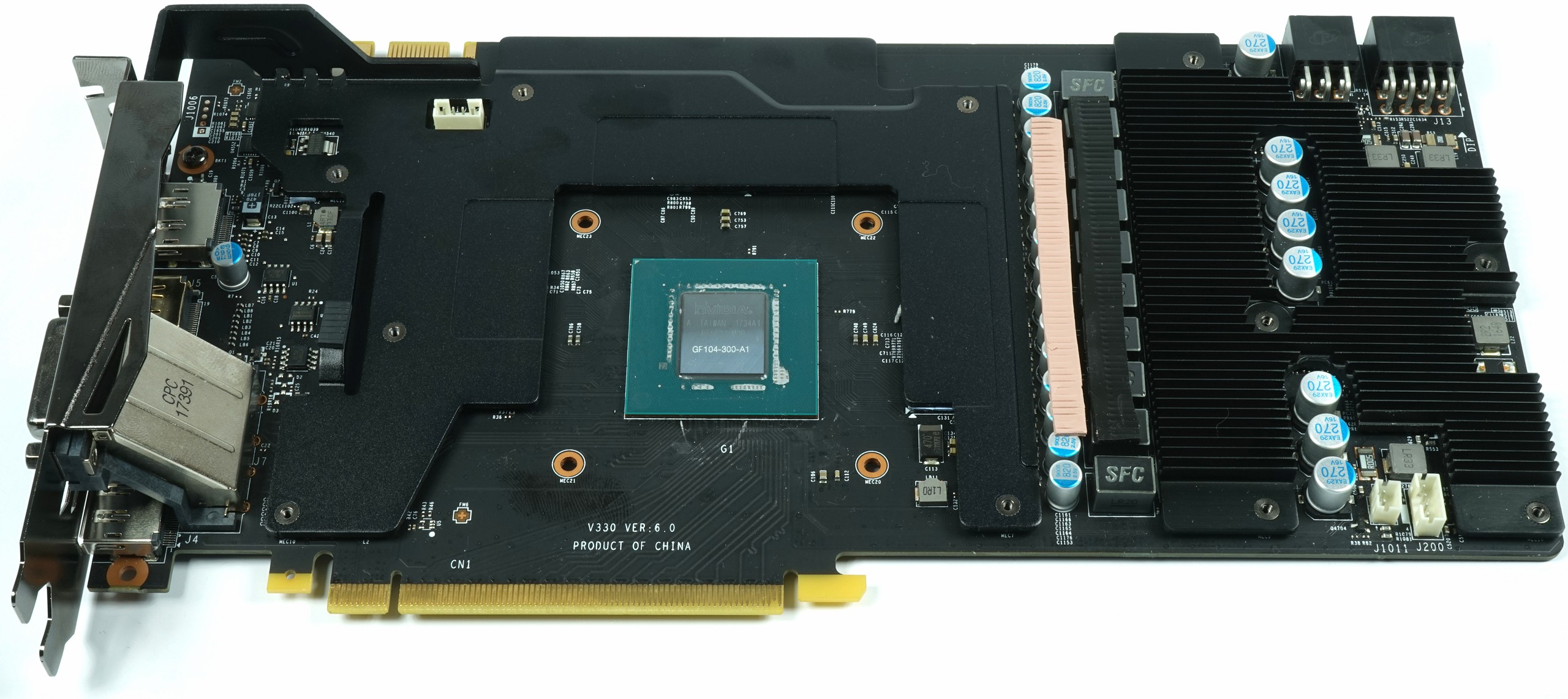
The voltage converter cooling draws significantly more surface from the consistent implementation with real cooling fins over the entire frame surface, which also absorbs the horizontal air flow of the fins above.
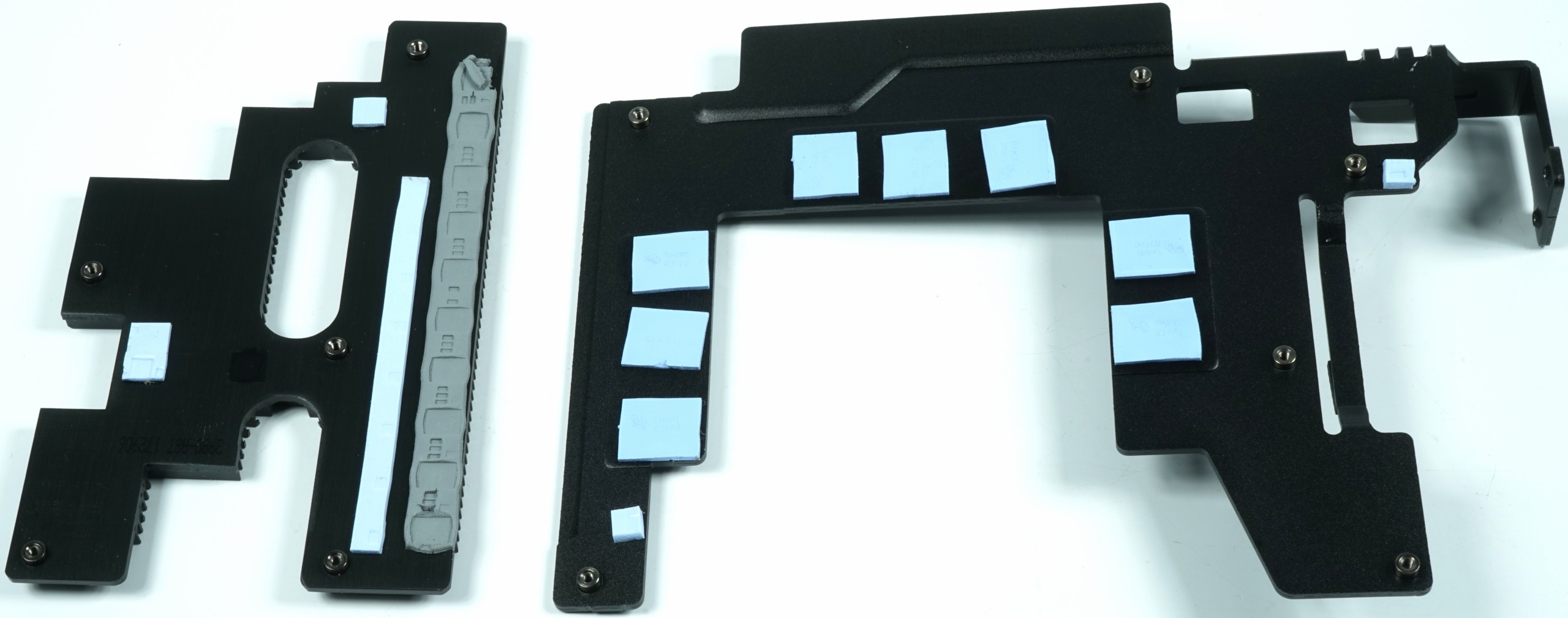
MSI is also now trying to cool down coils and capacitors by placing tons of pads between the components and the cooling fins of the large cooler. This cooler can also convince with its performance this time and relies on a nickel-plated heat sink for the GPU, as well as a total of five 6 mm hetapipes and an 8 mm heatpipe made of nickel-plated composite material.
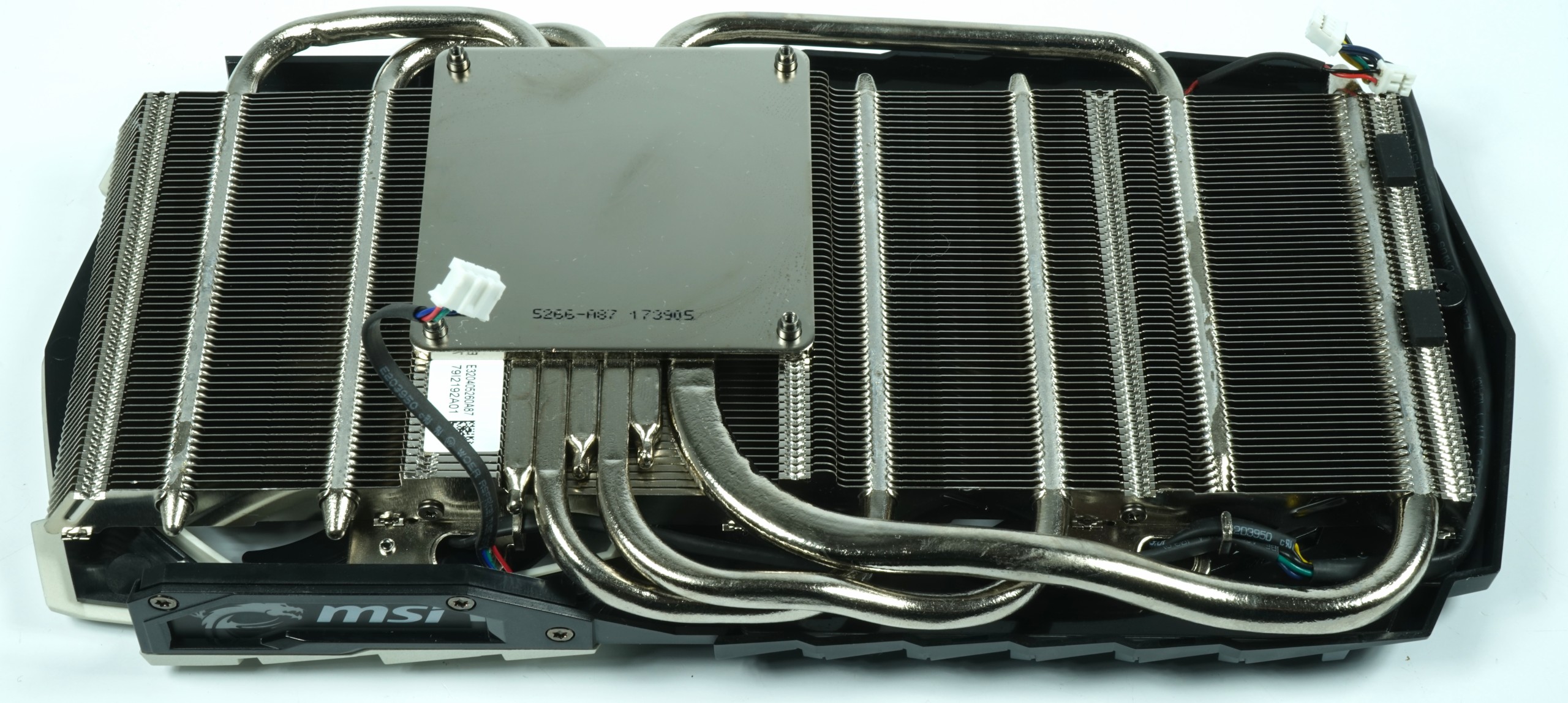
| Cooling system at a glance | |
|---|---|
| Type of cooler: | Air |
| Heatsink: | Nickel-plated heat sink for GPU |
| Cooling fins: | Aluminum, horizontal alignment related |
| Heatpipes | 1x 8mm, 5x 6 mm, nickel-plated |
| VRM cooling: | separate VRM cooler with cooling fins only MOSFETs are cooled |
| RAM cooling | via mounting frame |
| Fan: | 2x 10 cm fan modules (9.7 cm rotor diameter) 14 rotor blades semi-passive lyrised |
| Backplate | Aluminium, silver-metallic lacquered no cooling function, foiled inside |
Power supply and components
MSI has arranged the two voltage converters for memory above the total of 8 voltage converters for the GPU (four real phases with doubler) spatially within a row and thus also placed far enough of the memory modules. Their hotspot, which we had to criticize with the GTX 1080 Ti Gaming X models from MSI, is not an issue with this card.
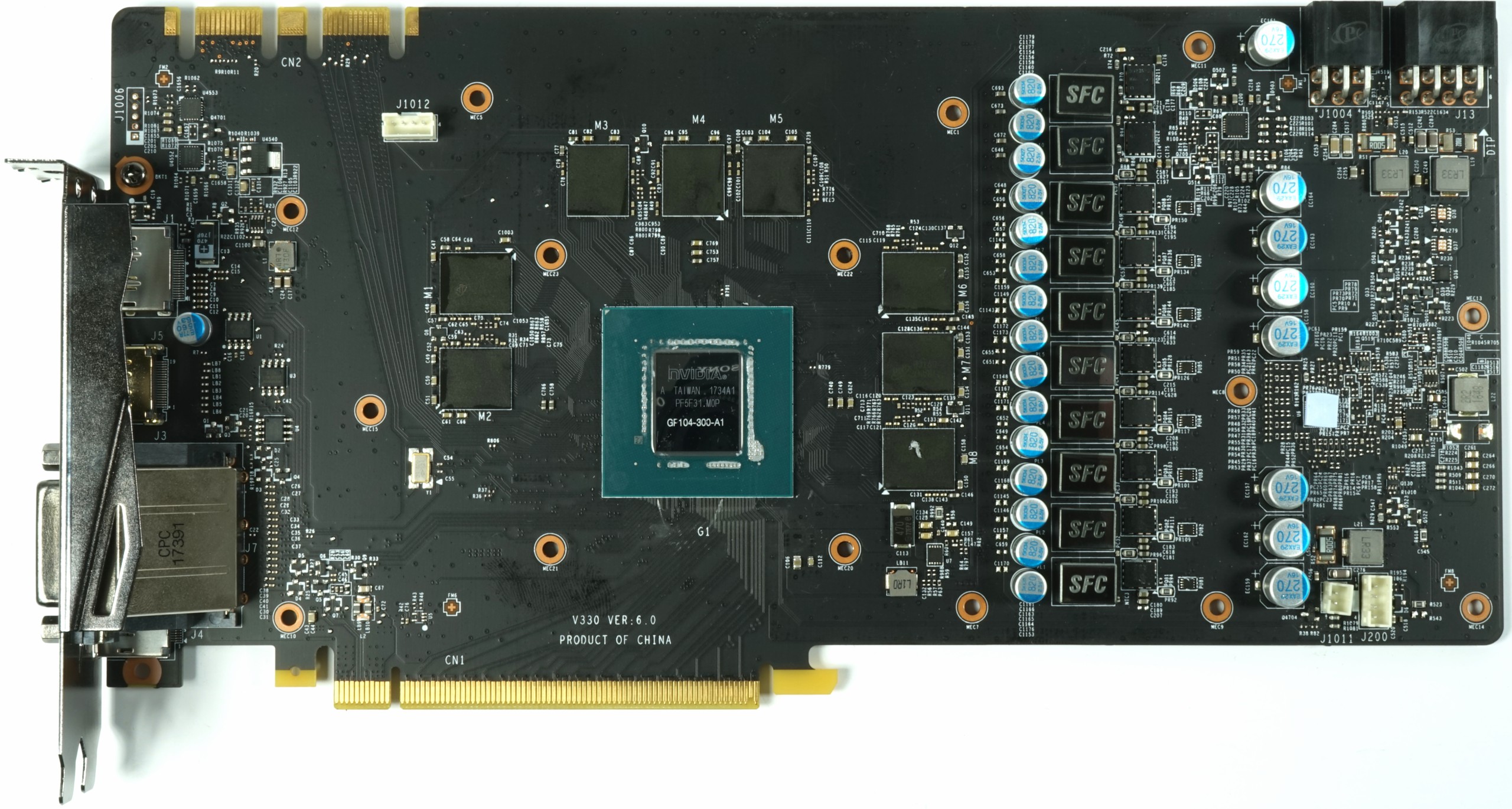
The 4+2 phase system relies on the standard uP9511P from UPI Semiconductor as a PWM controller. Since the PWM controller cannot directly address the MOSFETs of the individual voltage converter phases, MSI relies on the F6A4 as a gate driver for controlling the Power MOSFETs M3816N from UBIQ (UPI Semiconductor). This is a fairly resilient dual-channel MOSFET for the DC/DC voltage converter range with sufficiently high reserves.
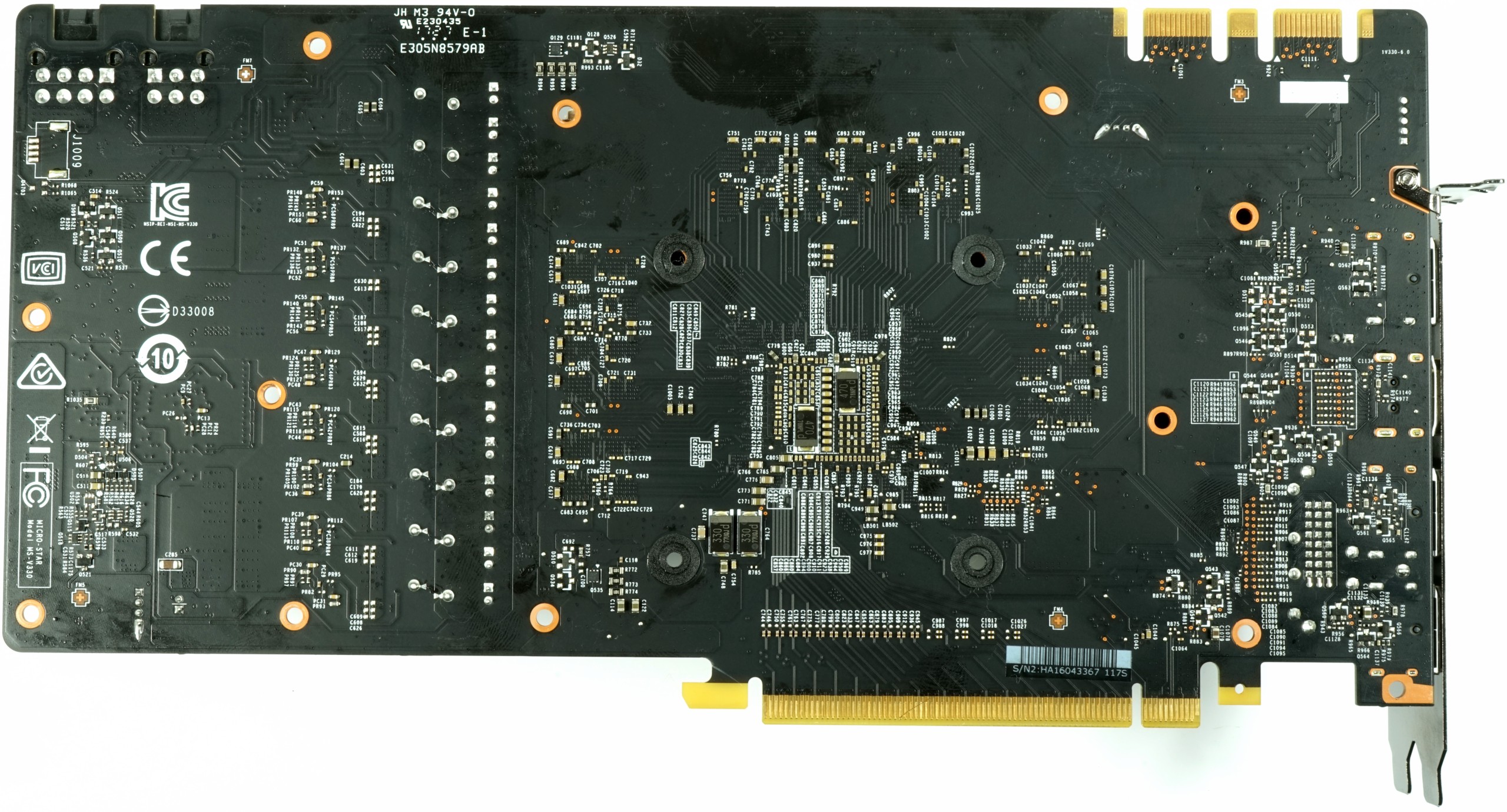
GPU Power Supply
|
||
|---|---|---|
| PWM Controller | uP9511 UPI Semiconductor 8-Phase PWM Controller |
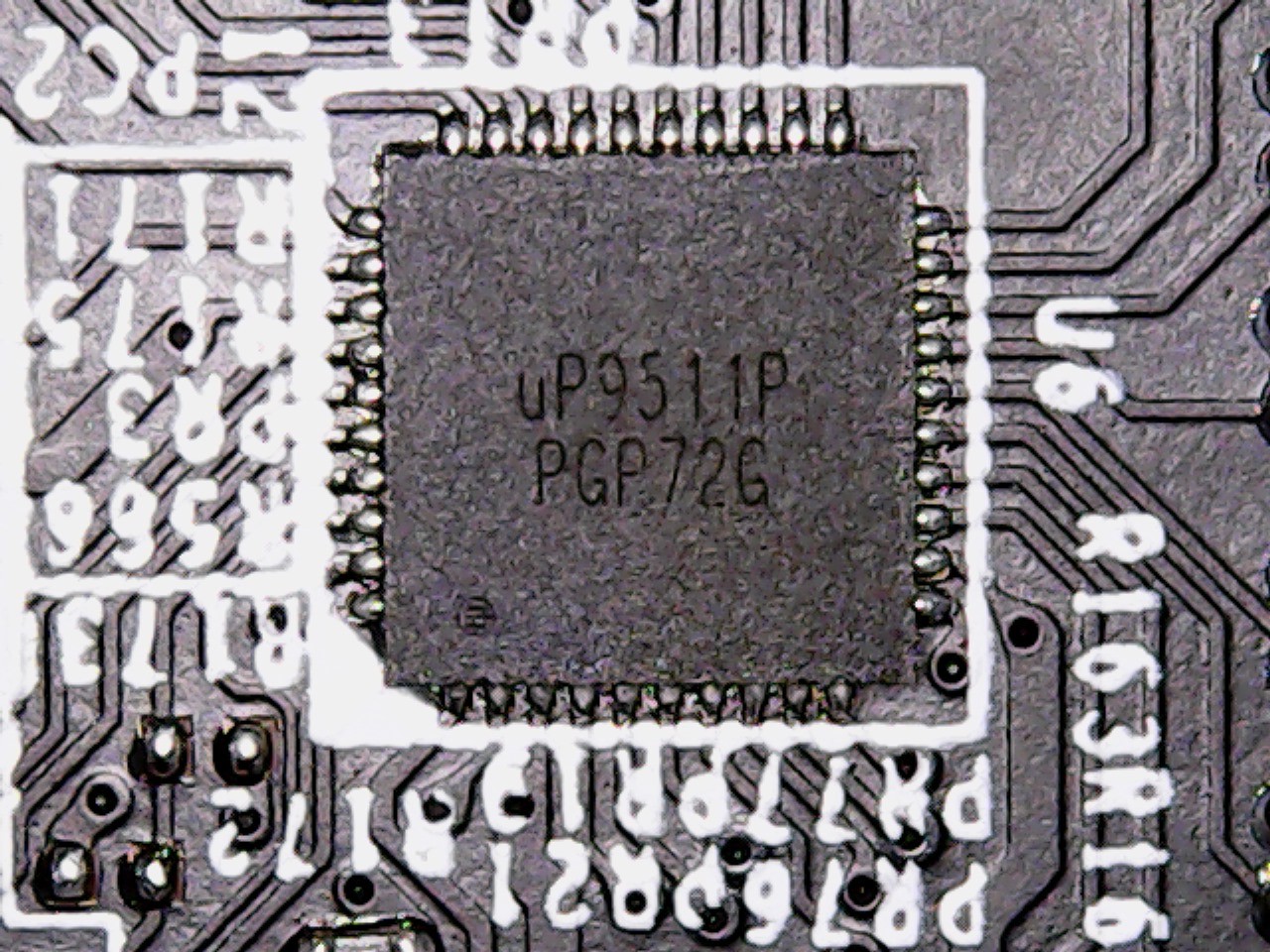 |
| Gate Driver | F6A4 Phase Doubler and Gate-Driver |
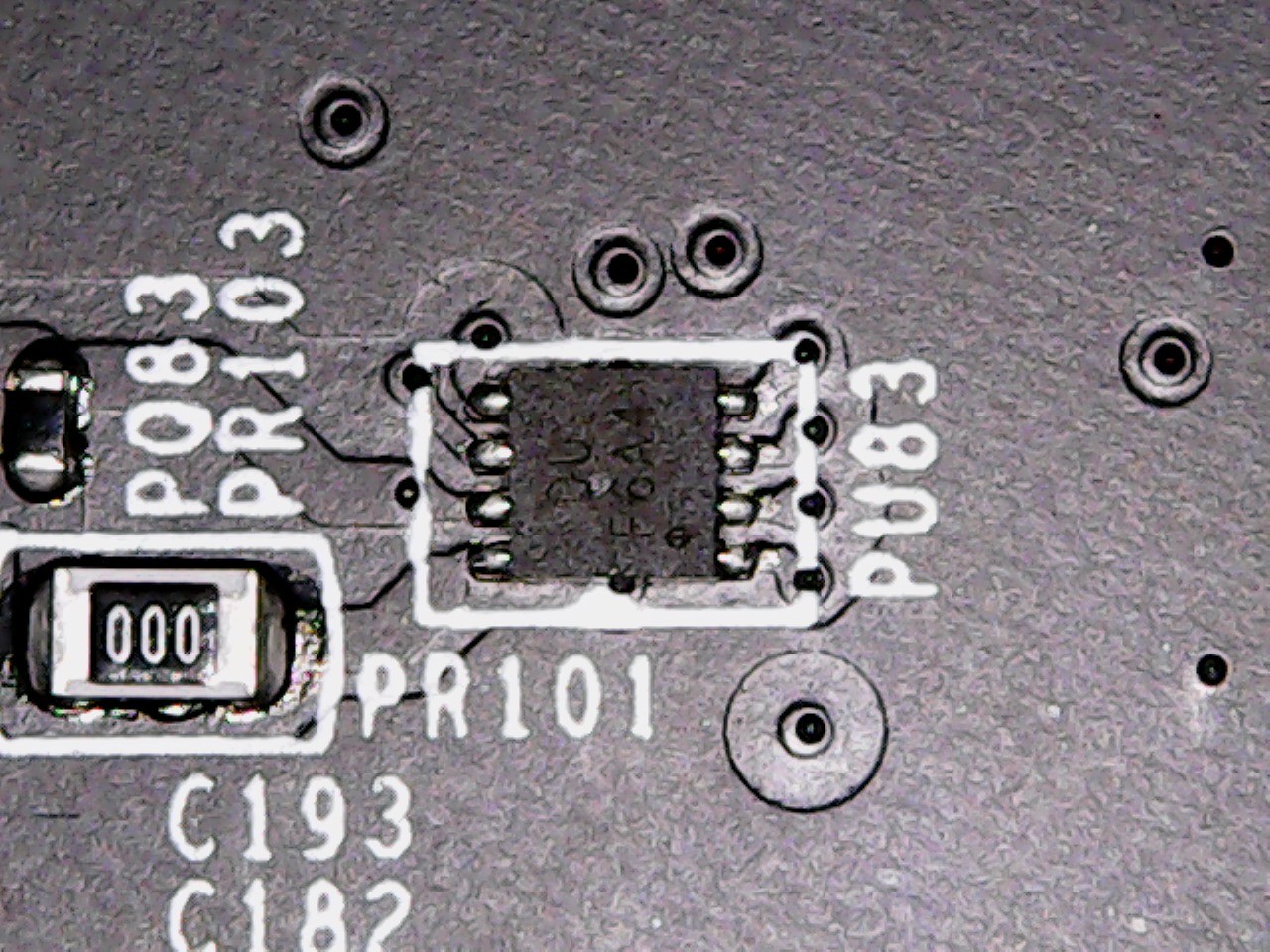 |
| Vrm | M3816N UBIQ (UPI Semiconductor) POWER MOSFET Dual-N-Channel High- and Low-Side |
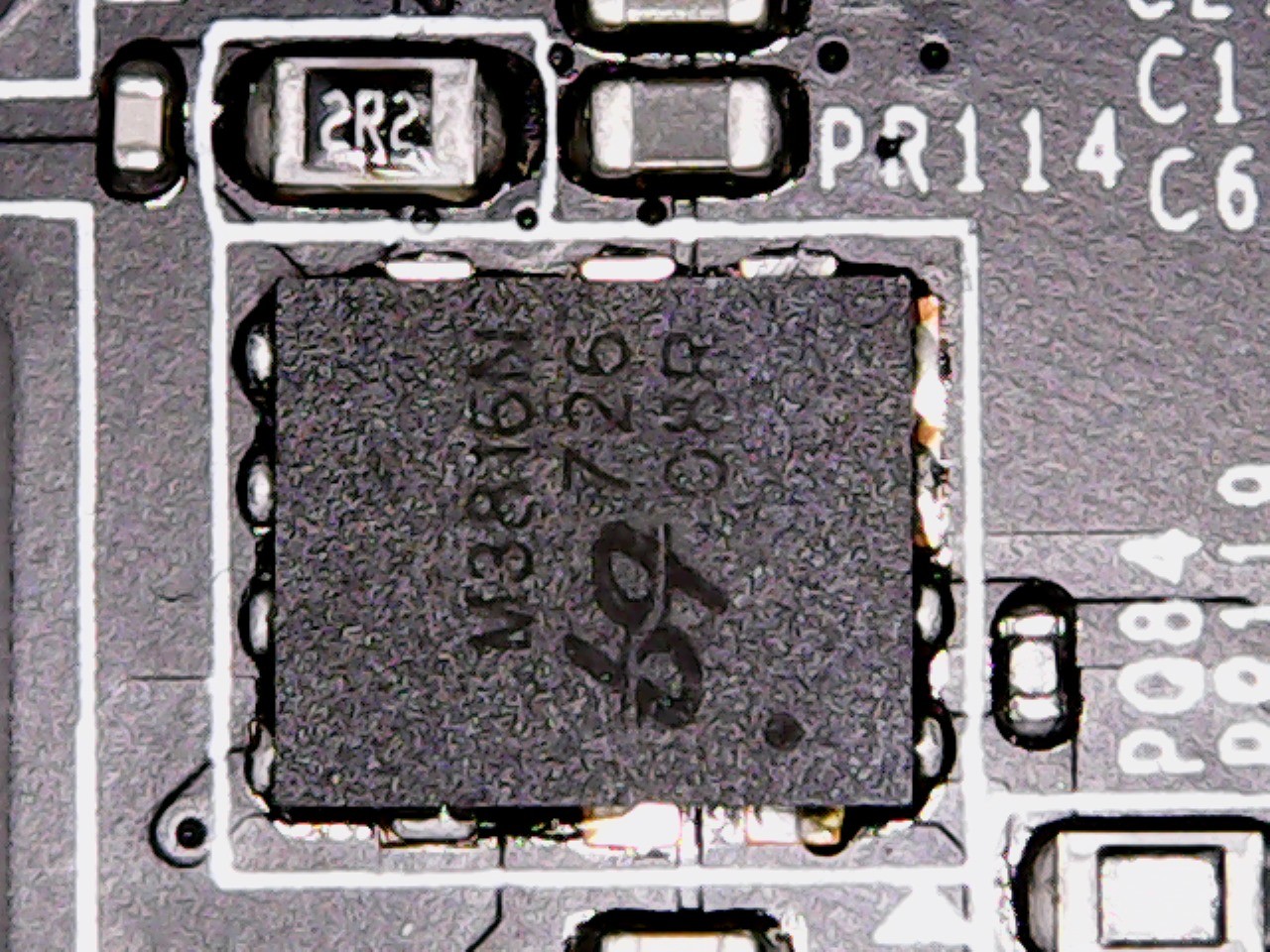 |
| Coils | Sfc Super Ferrite Choke Lianzhen Electronics |
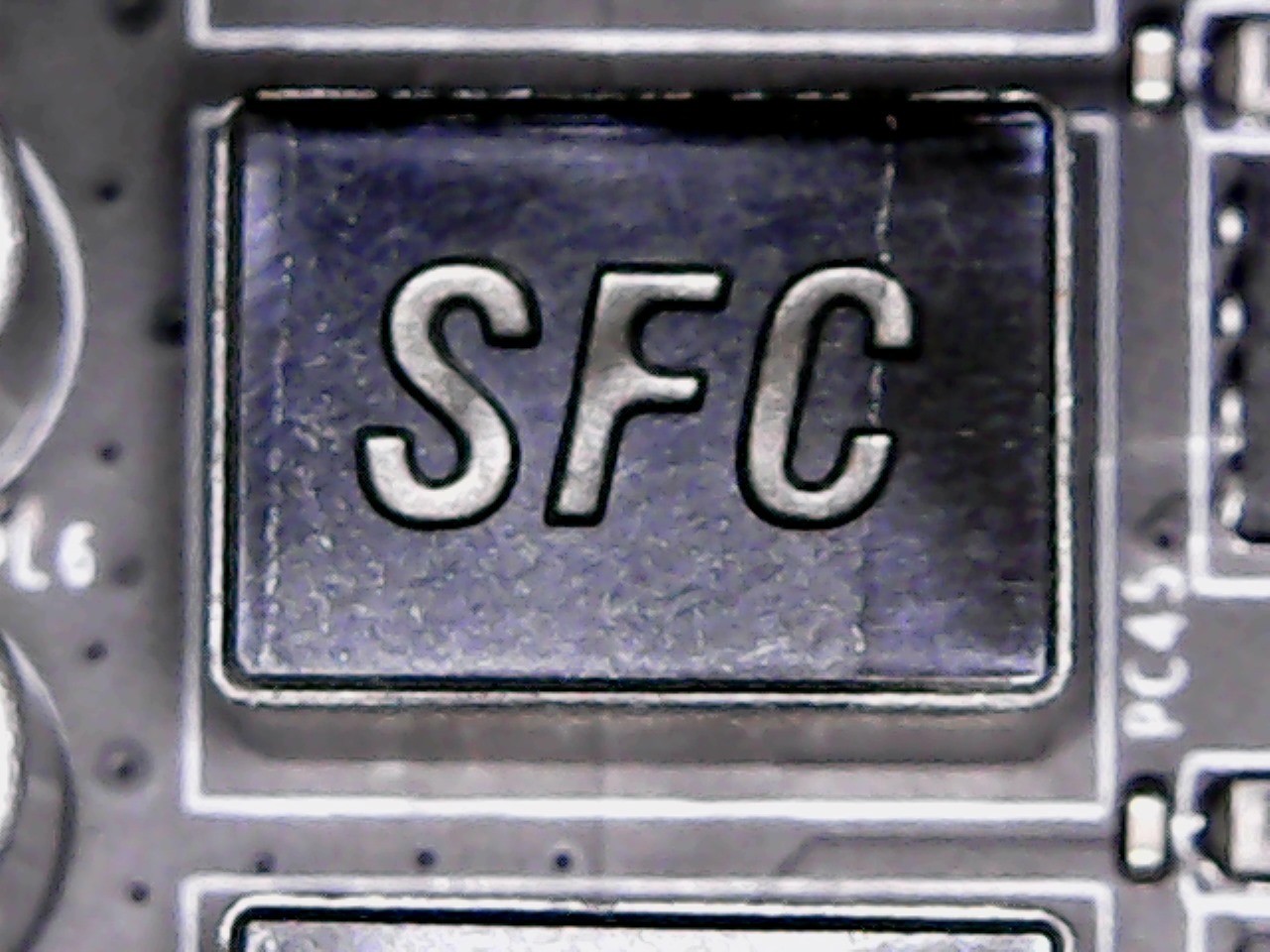 |
Memory and power supply
|
||
| Modules | MT51J256M32HF-80 Micron GDDR5, 8.0 Gb/s 8 Gigabit (32x 256 MBit) eight modules |
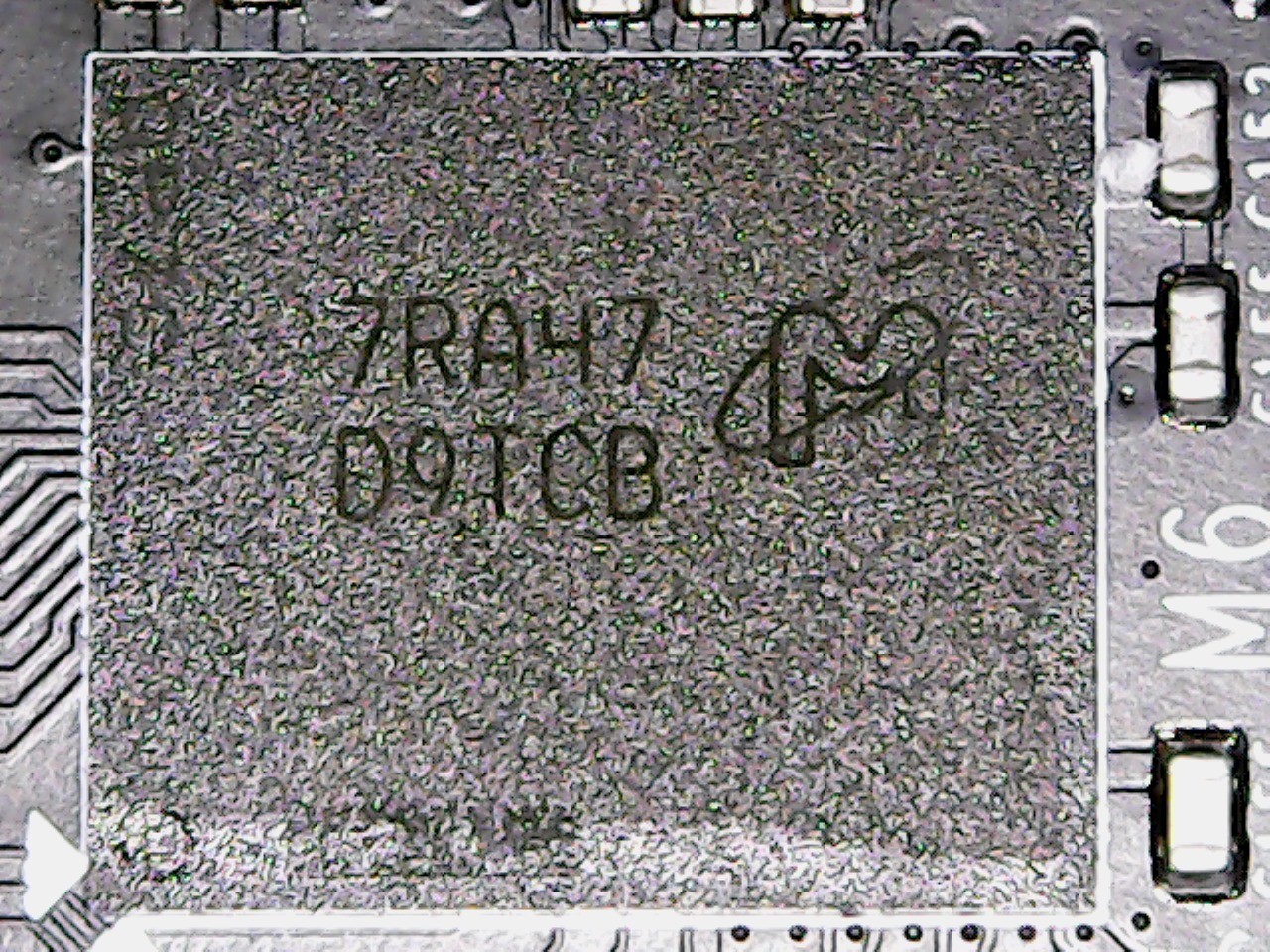 |
| PWM Controller | uP1641 UPI Semiconductor 2 Phase Buck Converter |
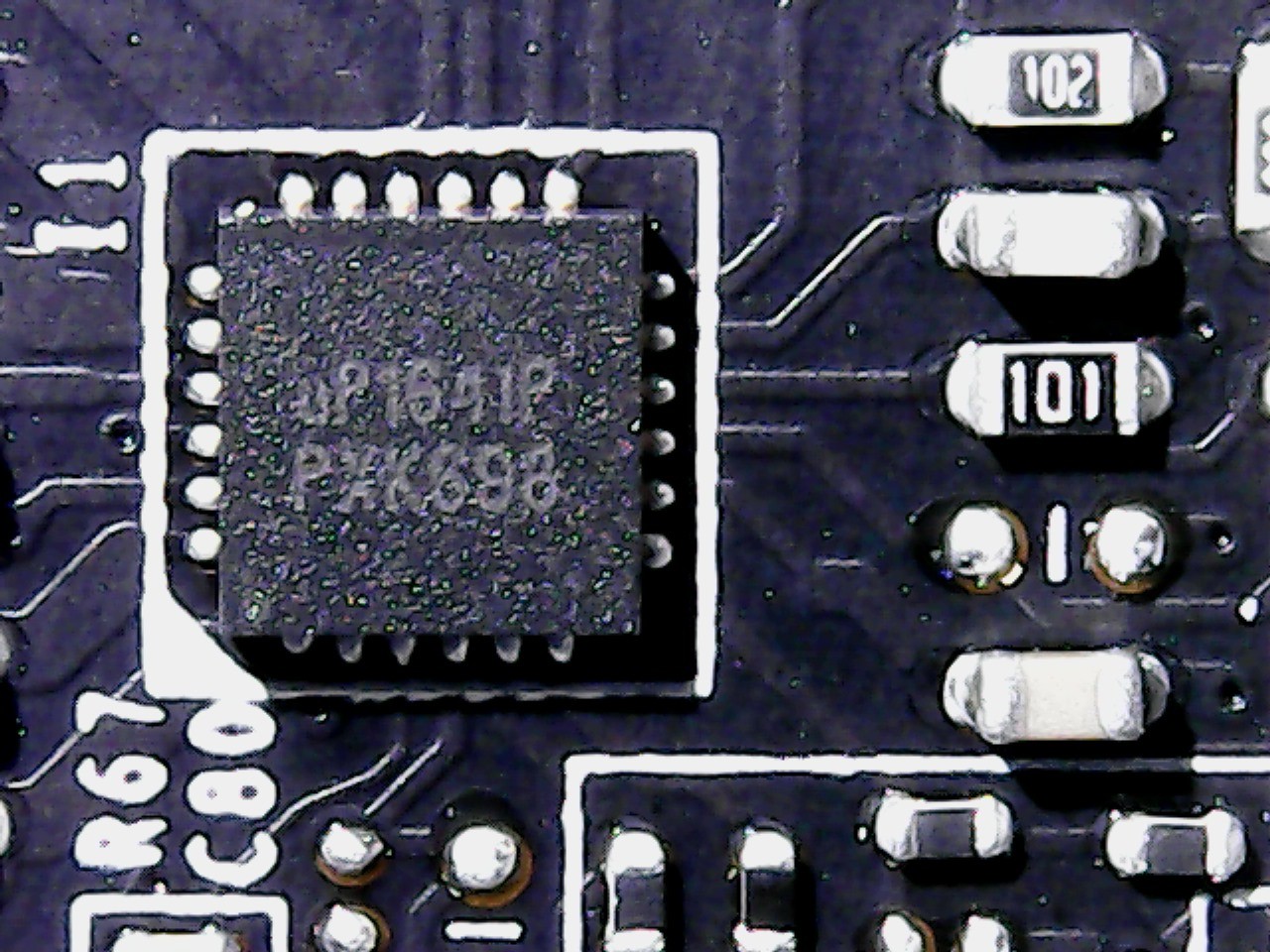 |
| Vrm | BSC0923NDI Infineon Clone Dual-N-Channel MOSFET High- and Low-Side |
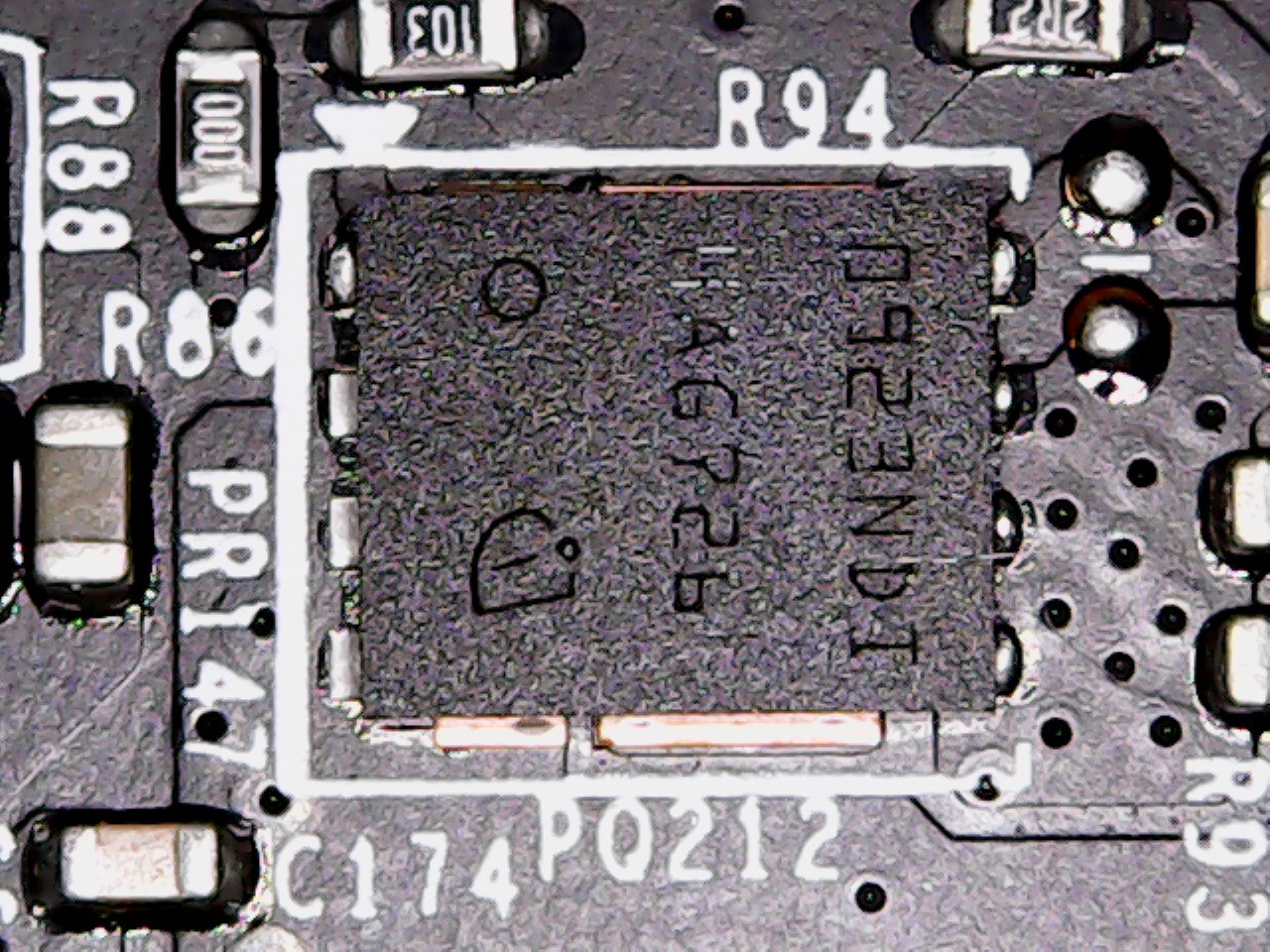 |
| Sfc Super Ferrite Choke Lianzhen Electronics |
 |
|
Other components
|
||
| Monitoring | INA3221 Monitoring Chip Currents, voltages |
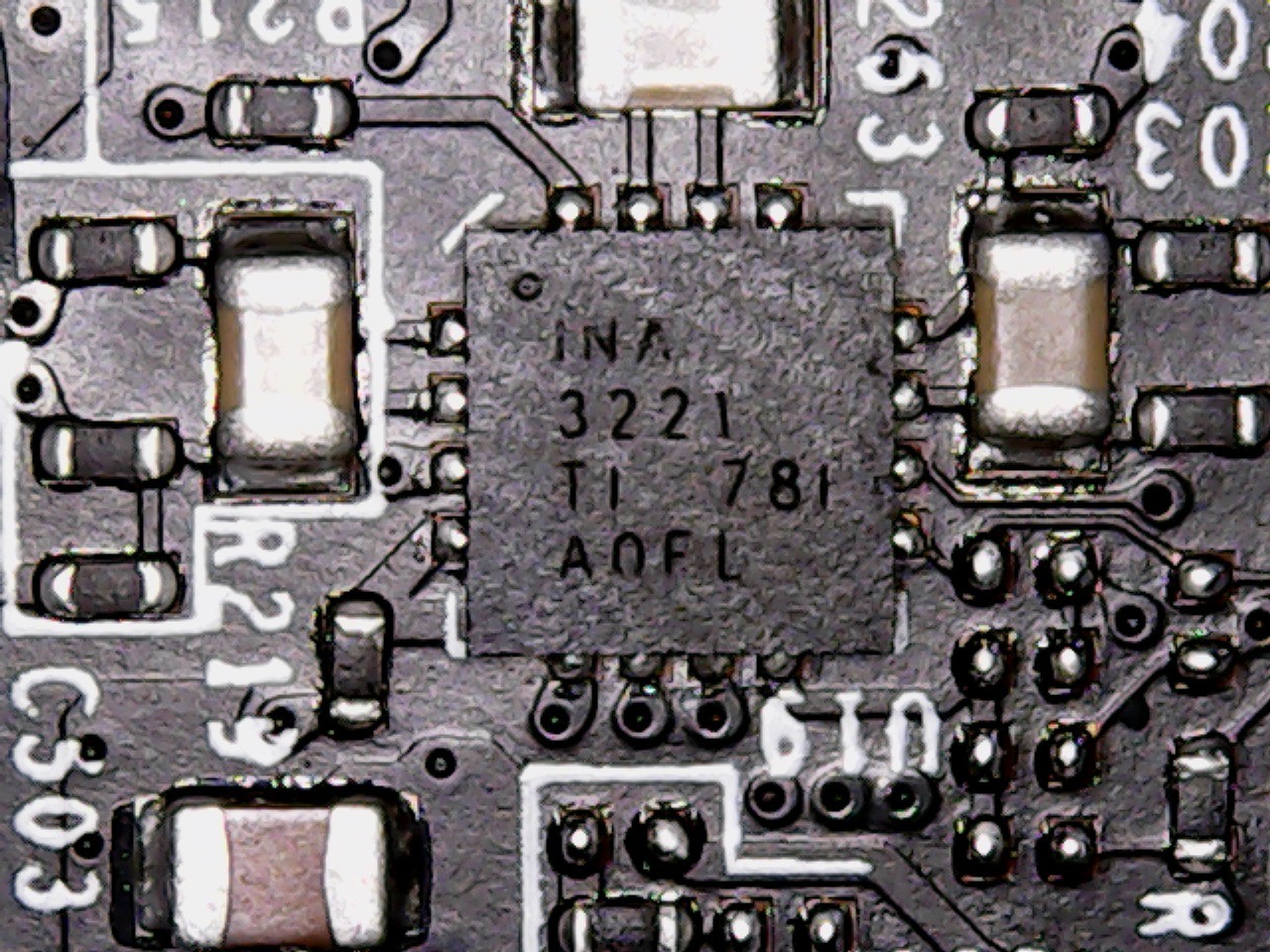 |
| Bios | Winbond 25Q40 Kynix Semiconductor Eeprom Bios |
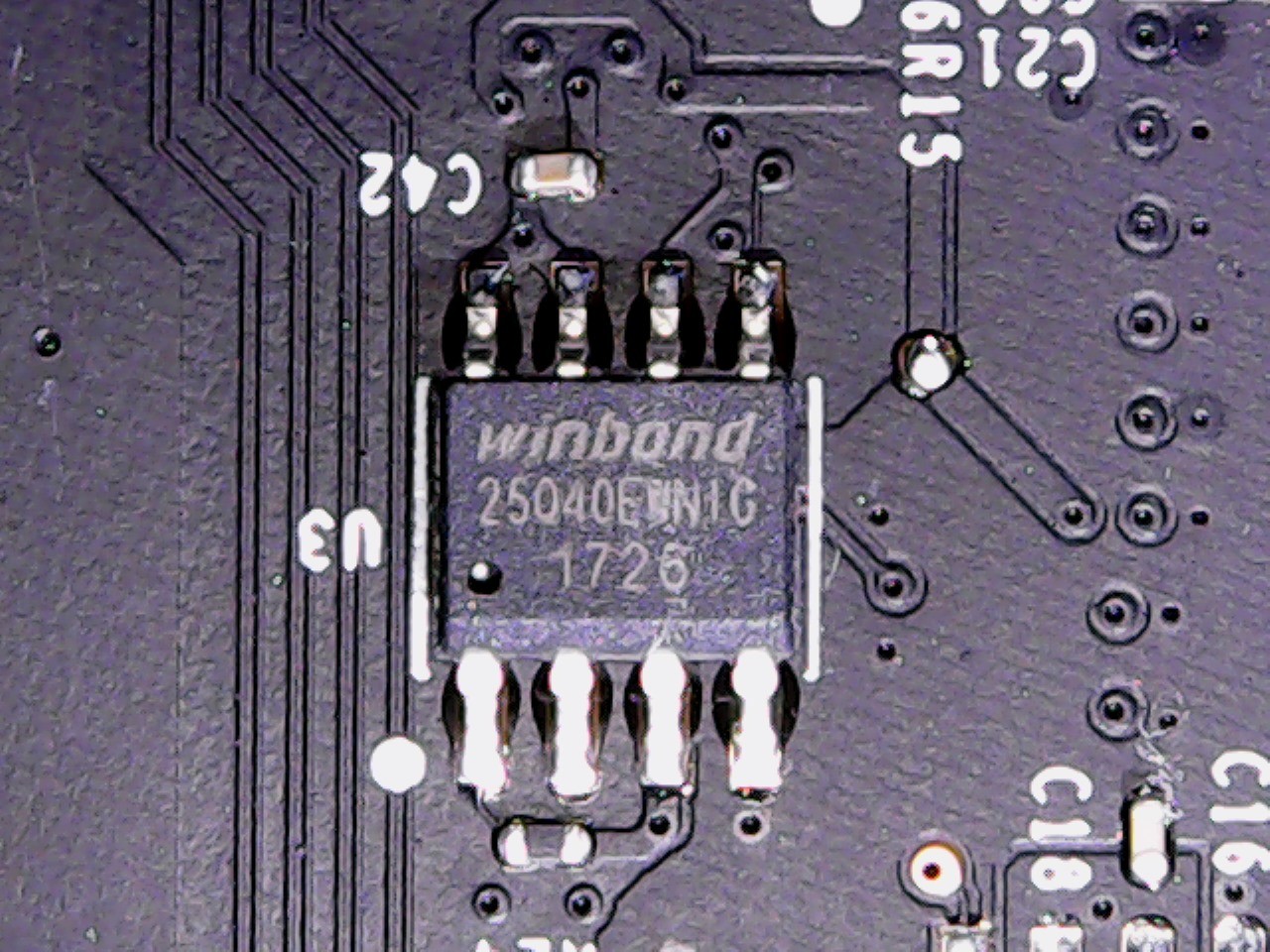 |
| Shunts and filters | 1x coil (smoothing) and shunt per PCIe socket (12V input voltage) | 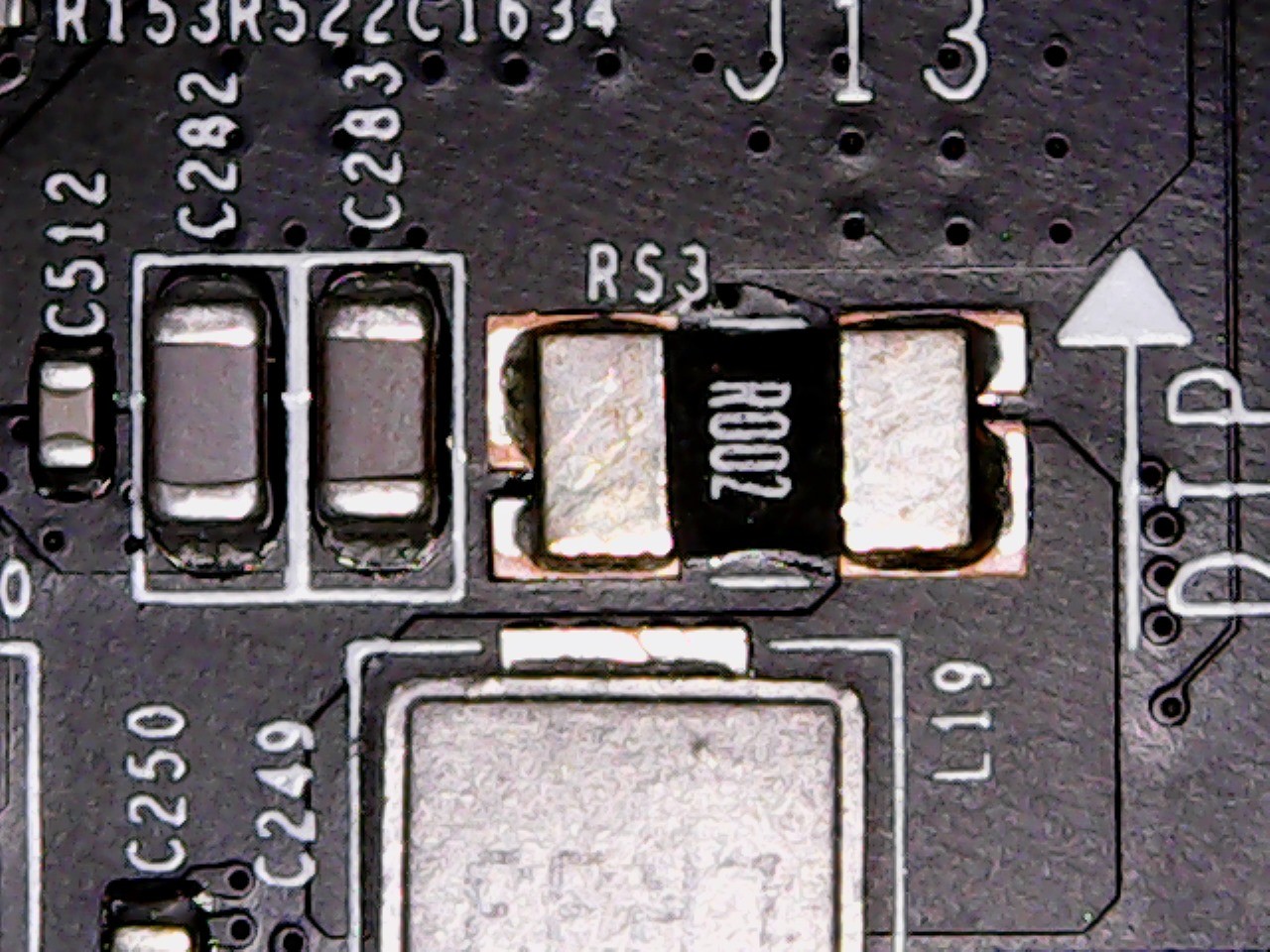 |
More details
|
||
| Other Features |
– 8-pin + 6-pin PCI-Express connectors for power supply – Filter coils in the entrance area |
|
- 1 - Übersicht und Testsystem
- 2 - Testsystem und -methodik
- 3 - Im Detail: Nvidia GeForce GTX 1070 Ti FE
- 4 - Im Detail: MSI GeForce GTX 1070 Ti Titanium
- 5 - Ashes of the Singularity: Escalation (DirectX 12)
- 6 - Battlefield 1 (DirectX 12)
- 7 - Destiny 2 (DirectX 11)
- 8 - Doom (Vulkan)
- 9 - Metro: Last Light Redux (DirectX 11)
- 10 - Middle-earth: Shadow of War (DirectX 11)
- 11 - Rise of the Tomb Raider (DirectX 12)
- 12 - Tom Clancy’s Ghost Recon Wildlands (DirectX 11)
- 13 - Tom Clancy’s The Division (DirectX 12)
- 14 - Warhammer 40,000: Dawn of War III (DirectX 11)
- 15 - The Witcher 3 (DirectX 11)
- 16 - Leistungsaufnahme im Detail
- 17 - Temperaturen und Takt
- 18 - Übertaktung
- 19 - Lüfterdrehzahlen und Geräuschentwicklung
- 20 - Zusammenfassung und Fazit
















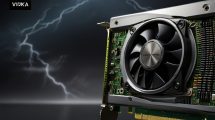
















Kommentieren